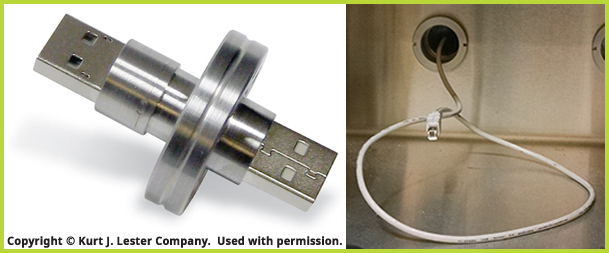General Electrochemistry
Back to General Electrochemistry Back to Applications Back to Knowledgebase HomePotentiostat Glovebox Installation
Last Updated: 5/14/19 by Neil Spinner
1Glovebox Installation
There are two practical ways to perform electrochemical experiments inside of a glovebox. Both require that the glovebox be equipped with special cable feedthroughs.
1.1Potentiostat and Electrochemical Cell in Glovebox
Placing the instrument and the electrochemical cell inside the glovebox is by far the easiest and preferred approach. By keeping the instrument close to the cell, the cell cables are shorter, minimizing interference from environmental noise sources. A special USB feedthrough port is required for this approach. This allows the computer controlling the instrument to remain outside the glovebox with only the USB communication signals passing through the wall of the glovebox. Inexpensive third-party USB cable feedthroughs are available (see Figure 1) that fit into the standard KF-style flanges commonly found on gloveboxes. Many Pine Research customers have successfully used feedthroughs offered by the Kurt J. Lesker Company (www.lesker.com).

Figure 1. USB Cable Glovebox Feedthrough
The instrument may be transferred into the glovebox by passing it through the glovebox antechamber. Any cables, power cords, or instrument accessories are also safe to bring into the glovebox through the antechamber. When ramping the antechamber down to vacuum, a gradual approach should be taken to prevent damage to instrument circuitry. The exact time needed to fully remove any residual air from the potentiostat and accessories varies by antechamber size and vacuum strength. While it is recommended to follow established glovebox user protocols, it is also suggested that the amount of time the instrument is exposed to vacuum be as short as possible. Once inside the glovebox, operation of the potentiostat is identical to outside the glovebox, though some signal noise may be introduced by the glovebox environment (vacuum pumps, gas valve actuators, vibrations, etc.). Once the instrument is placed inside the glovebox, it is a good idea to leave it in the glovebox; repeated cycling through the antechamber is not recommended.
1.2Electrochemical Cell Only in Glovebox
If the potentiostat must remain outside the glovebox, then it is possible to feed a longer version of the cell cable through a port in the wall of the glovebox. A port with a KF-40 flange is ideal, and epoxy can be used to seal around the individual cell cable lines as they pass through the flange (see Figure 2). To mitigate any signal noise picked up by the longer cell cable, an electrically conductive and earth grounded mesh may need to be installed around the cell cable bundle. Additionally, using a longer cell cable is likely to reduce the performance of the instrument when making EIS measurements. Specifically, the longer cell cables introduce additional stray capacitance into the measurement system and this is likely to reduce the accuracy of EIS measurements, particularly at higher frequencies.

Figure 2. Cell Cable Glovebox Feedthrough



